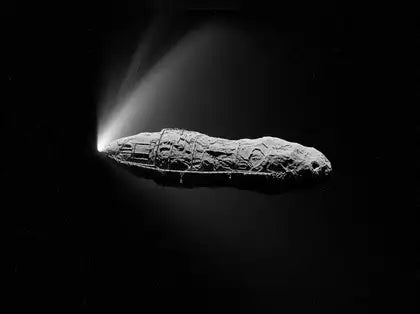In the vast expanse of space, where stars whisper secrets across light-years, few events capture the imagination like an uninvited guest from another star system. Enter 3I/ATLAS, the third confirmed interstellar object to breach our solar system, discovered on July 1, 2025, by the NASA-funded Asteroid Terrestrial-impact Last Alert System (ATLAS) telescope in Río Hurtado, Chile.
Dubbed a comet due to its icy nucleus and gaseous coma, this high-speed wanderer has astronomers buzzing with excitement—and fueling wild speculation. But is it a frozen relic from a distant world, or something far more extraordinary? As it hurtles toward its exit, clocking speeds up to 137,000 miles per hour (221,000 km/h), 3I/ATLAS offers a fleeting window into the universe’s hidden archives.
Discovery and Journey: A Bullet from the Stars
3I/ATLAS earned its name as the “3I” for the third interstellar interloper, following the cigar-shaped 1I/ʻOumuamua in 2017 and the more comet-like 2I/Borisov in 2019. Its hyperbolic orbit—curving outward like a slingshot rather than looping elliptically—confirms its extrasolar origin, with an eccentricity of about 6.15 and a hyperbolic excess velocity of 58 km/s (36 mi/s) relative to the Sun. That’s faster than its predecessors, suggesting billions of years adrift, accelerated by gravitational tugs from countless stars and nebulae.
Originating from the direction of Sagittarius near the Milky Way’s Galactic Center—uniquely from the southern celestial hemisphere, opposite the Sun’s motion—3I/ATLAS barreled in retrograde, tilting nearly 175 degrees to the ecliptic plane. It swung past Mars on October 3 at 18.6 million miles (30 million km), imaged by China’s Tianwen-1 orbiter and ESA’s ExoMars Trace Gas Orbiter.
Perihelion—its solar closest approach—hit on October 30 at 1.4 AU (126 million miles or 203 million km), just inside Mars’ orbit. Now outbound, it will graze Earth at 1.8 AU (170 million miles) on December 19—far too distant for binoculars, dimming below magnitude 12 by late 2025—and flirt with Jupiter in March 2026 before vanishing into the void.
NASA assures no collision risk; it’s a safe spectator. Yet its path, eerily aligning near Venus, Mars, and Jupiter, has sparked whispers of design amid the chaos.
What Scientists Say: A Comet’s Icy Secrets
The consensus? 3I/ATLAS is unequivocally a comet—an active one, at that. Initial ATLAS images showed no coma, but follow-ups from the Lowell Discovery Telescope, Canada-France-Hawaii Telescope, and Nordic Optical Telescope on July 2 revealed a marginal fuzzy halo and 3-arcsecond tail elongation, hallmarks of sublimating ices. Hubble’s July 21 snapshot, from 277 million miles away, pegged the nucleus at 0.44–5.6 km (0.27–3.5 miles) across, shrouded in a teardrop dust cocoon.
Spectral analysis paints a portrait of an ancient traveler. NASA’s Neil Gehrels Swift Observatory detected strong ultraviolet OH (hydroxyl) emissions in July-August, signaling water vapor—unusual at 3+ AU where temperatures should suppress sublimation. This hints at sunlight-heated icy grains feeding the coma, or a porous structure trapping heat.
Carbon dioxide dominates the coma, suggesting formation in a frigid, outer disk far from its parent star. Dust mass-loss rates climbed from 0.3 to 4.2 kg/s by late August, with a 16.16-hour spin and 0.3-magnitude light curve—typical for distant comets but surprisingly vigorous for an interstellar one.
Palomar and Apache Point spectra show reddish dust (like 2I/Borisov) but scant gas emissions, implying large grains resistant to solar wind. Polarimetry from VLT and NOT reveals unprecedented negative polarization and low inversion angles, marking it as a potential new comet class with exotic dust properties.
Nickel vapors in the plume—first for an interstellar object—defy expectations, as temperatures shouldn’t vaporize nickel-iron grains. James Webb’s August 6 infrared peek and Lowell’s post-perihelion Halloween shots (faint bluish hue, third color shift) add layers: cosmic rays may have zapped its surface over eons, altering composition.
Planetary scientist Darryl Seligman calls it a “messenger” from a potentially pre-solar-system era, twice Earth’s age, revealing exoplanet diversity. As it fades, missions like Parker Solar Probe and PUNCH continue tracking, probing thermodynamic shifts for clues to its birth.
Far-Fetched Hypotheses: Probes, Drones, and Dark Forest Dangers
While data screams “comet,” anomalies invite fringe theories. Harvard’s Avi Loeb, fresh off ʻOumuamua debates, flags nine “curiosities”: extreme nickel-iron ratios, no tail (or forward “glow”?), color flips, low non-gravitational acceleration (suggesting dense mass or dormant engines), and that uncanny planetary flyby alignment. In arXiv preprints, he and collaborators hypothesize a 30–40% chance it’s artificial—a mile-wide “mothership” probe, perhaps from a “Dark Forest” civilization (per Liu Cixin’s novel), silently scouting before potential hostility. Behind the Sun at perihelion, it could thrust into solar orbit, deploy “mini-drones” toward Earth (arrival by December), or rendezvous with Jupiter—testing the “Berserker” idea of self-replicating killers enforcing cosmic silence.
Loeb muses it dwarfs Starship, implying tech “well beyond ours.” Elon Musk and Joe Rogan riffed on it as a Tunguska-like recon vessel, tying unauthorized SpaceX signals to alien intrigue. SETI counters: no acceleration means no propulsion; it’s natural outgassing. Yet, as Loeb quips, “Zebra is identified by its stripes”—extraordinary claims demand proof, but anomalies persist.
Echoes from the Void: What 3I/ATLAS Teaches Us
Whether icy time capsule or disguised envoy, 3I/ATLAS underscores interstellar objects’ rarity—expect more with advancing scopes. It challenges models of comet formation, dust evolution, and exoplanet chemistry, reminding us the cosmos defies tidy boxes. As it slips away, telescopes strain for final glances, blending rigorous science with the thrill of the unknown. In three minutes of cosmic pondering, one truth endures: the stars aren’t silent—they’re just waiting for us to listen closer.










Share:
Musk’s Mandate: Tesla Shareholders Greenlight $1 Trillion Pay Package, Cementing Capitalism’s Boldest Bet
Israel’s Digital Diplomacy: Rebuilding Evangelical Support Amid Global Backlash